
ISHIDA Takashi Solo Exhibition “Light on the Arc”
April 20 - June 16, 2019, 10:00-18:00
air2019-1en
ISHIDA Takashi
ISHIDA Takashi

Photo: SHIRAI Haruyuki
Person in the Vortex
KANEKO Yukiko
The gallery A of Aomori Contemporary Art Centre (ACAC) has a 6-meter high ceiling and almost 60-meter long arced walls. The viewer experiences the exhibition as they walk towards the back of this long arced space, which resembles a corridor. In this text, I will reflect on the exhibition in three parts; the first, middle, and final part, in the same order that the viewer would experience it.
1. Vortex Architecture
When we look at the arc-shaped gallery building from a bird’s eye view, we see that the building is designed with a circle as its key motif. The arced-shaped gallery and the fan-shaped shallow pond fit into the perfect circle. The first in a series of video works: Winter Drawing / Drawing on the Snow, which is displayed by the gallery entrance has captured this structure. The video shows Ishida making drawings by spraying water on the concrete pathway that cuts right through the circular exhibition hall. It starts with the camera close to the ground, the camera gets elevated as Ishida moves towards the middle of the pathway, and eventually it captures the entire circular exhibition hall in the frame. While Ishida is drawing lines in the middle of the circle, shown from the above, the viewer’s eyes are attracted to the circular building and the snow-covered trees surrounding it. In the middle of the whiteness of snow, the circular shape creates a cavity, resembling a black hall. As our eyes move towards the center of the circle, the elevation decreases by layers; from the roof level, the piled-up snow level, to the ground level. The height differences create an optical illusion of the spiral going down towards the center of the circle. There at the very bottom of it, Ishida is making the pattern of vortexes.
Across from Winter Drawing / Drawing on the Snow, the video work A room of stone mirror— from The Post Gallery is displayed, which was created during Ishida’s stay in Ibaraki Prefecture. In this video, a green ventilation fan on the wall rotates occasionally and lines get drawn on the wall with water and chalk as if the rotation created those lines. To the right hand side of it, another video work Billowing Light 2 is projected, showing constantly changing billows. As I have described so far, Winter Drawing / Drawing on the Snow, which is pointing out the circleness of the building, and two other works related to vortex are placed together in the first part of the gallery. This gives the viewer an impression that for Ishida the arc and circular shapes of the ACAC building and vortex are related.
2. Disappearance and Reappearance of the Windows
In the middle section of the gallery, the work Light on the Arc, which was created during Ishida’s stay at ACAC, is displayed. Similar to the drawing animations he has made in the past, this work shows the process of lines being produced while the early-spring light of March is coming in from the gallery’s upper windows and moves over the frame.
Talking about the works shown in this exhibition, Square Window and Between Tableau and Window both have a square window and paintings on the wall or on the tableau that try to transform, modify, and seep through the square in the videos. The paintings go beyond the tableau and advance onto the wall, trying to nullify ‘inside and outside’ set by the frame of the tableau. However, the painting lines never goes over the canvas in the new work, on which Ishida has painted the actual configuration of the gallery space. As we watch the video capturing the canvas from the beginning, organic orange and yellow lines cover the canvas for a while. A few times in the middle of the video, a cross shape appears, as if made by the light casting a shadow of the window. Afterwards, an arc shape painted with green, blue, and white lines, resembling the gallery’s floor, appears and then the wall surface painted in the same style appears in clear perspective. They eventually get covered by white in “munyu munyu”[1]. But unlike the lines in Between Tableau and Window, which completely cover everything, in this work munyu munyu only cover the previously painted lines to the extent where they faded but still visible. In the video Between Tableau and Window, it seems that time, space, and Ishida’s action were painted on and encapsulated into the wooden panel. The wooden panel shown along the video has thick layers of paint, representing physical accumulation. Furthermore, the panel is painted over with white. As a result, it contains all the things that took place during the production, but what was painted can only be seen in the video. In contrast, while also containing the action, the video Light on the Arc shows the space where the action took place painted onto the canvas. If the panel in Between Tableau and Window was thought of as a projector projecting the white light, which includes all colors of lights, accumulating all Ishida's actions, then we could say that the canvas in Light on the Arc can be thought of as a camera framing the landscape in front of the lens.
In the Light on the Arc video, the window existing in space in reality is not captured. Instead, the canvas plays the role of the window and the frame in this work. Therefore, the lines must not go beyond the canvas and the framed landscape must have been contained within the canvas.
3. Inner Child
Passing beyond Light on the Arc, the viewer sees the sculptural works Sculpture / 4:3 and Dance and the video work Transmitted light / EMAKI at the end of the arc-shaped gallery.
The series of sculptures Sculpture / 4:3 placed on the lower pedestals are lit from the top at an angle so that as they go towards the back they cast longer shadows. These shadows lead our eyes towards the shadows created by Dance, cast on the back wall. In contrast to the painted pieces of Sculpture / 4:3, Dance is monochromatic and composed of many sculptures concentrated together on the floor, which cast complex shadows. Above these sculptures, the video work Transmitted light / EMAKI, in which the images keep moving upwards, is projected. Similar to the relationship between physical films and moving images created by casting light onto the films, the sculptures (physical objects) create the shadows (images, which are non-physical).
The video work Toy, which is displayed as the very first work at the exhibition entrance, was created by turning the photographs of the sculptures into an animation. Here again, the physical three-dimensional objects (the sculptures) return to the non-physical video images.
In the email interview[2], Ishida talked about the experience of using a fretsaw to make the sculptures and how they made him remember the surprises and joys he felt with making drawings in his childhood. He also talked about his childhood episodes in the artist talk for this exhibition and in an interview in his past catalogue “Billowing Light”[3]. For Ishida, who has been drawing with the impulse to express undefinable things existing at the very bottom of his unconsciousness at the spur of the moment, it seems impossible for him to ignore the connection between the concept of his own identity and the blurry memories of his childhood. In this sense, as the title implies, the work Toy, in which the artist freely played with the plates cut with a fretsaw and captured the changes happening in the play, functions as a trigger to wake the inner child in the artist and as a lighthouse omitting light signals in the darkness.
To Conclude – Vortex of Flow of Life
In his book “Lines: A Brief History”, where he freely examined the lines created from different activities of humankind and other creatures, Tim Ingold described about the drawings made by the Warlpiri people in Australia. He wrote: the circle and spiral they use to draw a certain place are “the very flow of life circling around one focal point”[4] and the center point of this place is “the absolute halt point, where their ancestors would go back to the ground where they came from”[5]. As the exhibition title “Light on the Arc” indicates, I could experience Ishida’s flow of life continuing from his inner child’s time on the arc: part of the ACAC building, consisting of the circle and spiral, which are interpreted as a vortex in Ishida’s mind. When imagining what is in the center, the last scenes of Winter Drawing / Drawing on the Snow come to my mind. In the videos, Ishida is making drawings by spraying water, but as time passes, water evaporates and the drawings on the ground disappear. Although the drawings disappear, or actually because the drawings disappear, Ishida is intently making drawings in the center of the vortex created by the building. He is doing it because he knows that what came from the ground would go back to the ground in the center of vortexes.
[1] Ishida calls organic lines in his work munyu munyu.
[2] From the response on September 6, 2019
[3] “Billowing Light”, edited by Yokohama Museum of Art and Okinawa Prefectural Museum & Art Museum, published by SEIGENSHA Art Publishing Inc., 2015
[4] “Lines: A Brief History” by Tim Ingold, translated by Shin Kudo, published by Sayu Publishing, 2014, p.158
[5] Same as footnote 4, p.159
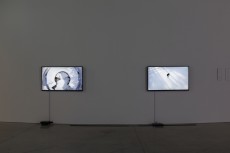
Winter Drawing / Drawing on the Snow, 2019
HD video (color, sound), 2 min. 30 sec.
HD video (color, sound), 10 min. 04 sec.
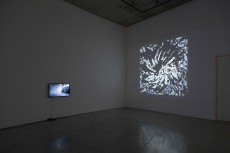
Left
A room of stone mirror—from The Post Gallery, 2016/2019
HD video (color, silent), 2 min. 24 sec.
Right
Billowing Light 2, 2016
HD video (color, sound), 2 min. 50 sec.
Sound by HAYASHI Nobuhiko

Square Window, 2015
HD video (color, sound), 6 min. 30 sec.
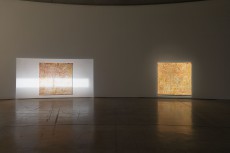
Light on the Arc, 2019
Video (color, silent), 3 min. 17 sec./
Oil on canvas, 200 x 200 cm/
Canvas (200 x 200 cm), HD video (color, 3 min. 26 sec.)

Between Tableau and Window, 2018
HD video (color, silent), 4 min. 33 sec./
acrylic on canvas, 110.5 x 146.7 cm/
16min film video (color, silent), 2 min., 13 sec. ※Not on exhibit

Front
Sculpture / 4:3, 2019
oil paint and lacquer on basswood plywood and MDF,
dimensions variable
-
Floor in the back
Dance, 2019
MDF, dimensions variable
-
Wall in the back
Transmitted light / EMAKI, 2016
HD video (color, sound), 3 min. 18 sec.,Sound: HAYASHI Nobuhiko
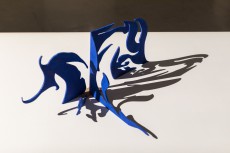
Sculpture / 4:3, 2019
oil paint and lacquer on basswood plywood and MDF
dimensions variable

Sculpture / 4:3, 2019
oil paint and lacquer on basswood plywood and MDF
dimensions variable
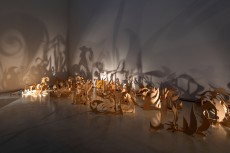
Dance, 2019
MDF, dimensions variable
石田尚志展「弧上の光」
2019年4月20日(土)-6月16日(日)10:00-18:00
石田尚志
ISHIDA Takashi

撮影:白井晴幸(以下も全て)
渦の中の人
金子由紀子
国際芸術センター青森(ACAC)のギャラリーAは6mの天井高に60m弱の壁面が続く弧形で、鑑賞者はこの弧形の長い廊下のようなギャラリーを、奥へと歩みを進みながら展覧会を体験する。本稿はギャラリーでの体験に合わせた前半、中盤、後半の3つに分けて本展について考えてみたい。
1.渦の建築
ACACの建築を俯瞰すると、ギャラリーを擁する展示棟は円形を基軸として設計されており、正円の中に弧形のギャラリーと扇形の水のテラスがすっぽり収まっている。この構造を捉えたのが、ギャラリー入り口付近に置かれた2点組の映像作品《冬の絵・雪上絵画》のうちの1点である。そこでは、展示棟の円形の中央を貫くコンクリートの通路に、石田が水を吹き付けて絵を描いている。そこでは地面に近い位置から映像が始まり、石田が通路中央に向かうにつれてどんどんカメラが上昇していき、やがて展示棟の円形が全て画面の中に納まる。上方から捕らえられたその円の中心では石田が線を描いているが、見る者の目は円形の建築とその周辺の雪に埋もれた木々に引き付けられる。雪の白色の中心に、まるでブラックホールのように円形は窪みを作り、屋根の高さ、積もった雪の高さ、地面の高さと、層になって中心に向かうごとに低くなる様子によって、円形が螺旋状に中心に向かって降りていくような錯視を起こさせる。そしてその最底辺部分では石田が渦巻きの図柄を描いている。
《冬の絵・雪上絵画》の向かいには、茨城県で滞在制作された《石の鏡の部屋 《旧展示室》より》が展示されている。ここでは時折、壁面に取り付けられた緑色の換気扇が回り、その回転から派生するように壁面に水やチョークで線が描かれる。その右手にはぐるぐると渦巻きながら変化する《渦巻く光2》が投影されている。このように、円形の建築を示した《冬の絵・雪上絵画》の周辺に渦に関連した他の二つの作品がまとめられ、ギャラリー前半部分で、石田にとってACACの建築の弧と円が渦につながるものであることが印象付けられる。
2.窓の消失と出現
ギャラリーの中央部分には滞在制作によって生まれた《弧上の光》が据えられた。本作は過去作のドローイング・アニメーションと同様、線が生成される様子がギャラリー上部の窓から入り込む3月の早春の陽光の動きと共に捉えられている。
本展に出品された作品で言うと、《正方形の窓》、《絵と窓の間》では画面の中に矩形の窓が納められ、壁面またはタブローへの描画は、その矩形の変形、変容、浸食、滲出が試みられる。それはフレームによって規定される「あちら側」と「こちら側」の無効化の試みでもあった。しかし本作で描線はキャンバスからはみ出すことは無い。その上、石田はこのキャンバス上にギャラリー空間の具体的な形状を描いている。キャンバスを捉えた映像を見ていると、一筆目からしばらくは、オレンジや黄色の有機的な線がキャンバスを覆っていく。中盤何度か、窓から差し込む光に照らされた窓枠を象るような十字が現れる。その後、緑や青、そして白の線でギャラリーの床面のような弧形が、そして壁面が明らかな遠近法を伴って現れる。それはまた白い「むにゅむにゅ」[i]に覆われていくが、白い線は、《絵と窓の間》のように全てを白く塗りこめるようなものではなく、あくまでもこれまでの線の重なりが見える程度に覆われる。《絵と窓の間》では、木製パネルに時間と空間、そして石田の行為が塗り込められたように見え、映像と共に展示されたパネルの上には実際に分厚い絵の具の層があり、そこに物理的な蓄積を見出すことができる。更にそのパネルは白で塗りつぶされている。ここで提示されるパネルは塗りこめられることでその創作の全てを内包するが、何が描かれたか、その形を追うことは映像の中でしかできない。対して、《弧上の光》では行為を内包しながら、その行為が行われた空間が具体的に、キャンバスの上に描かれている。《絵と窓の間》のパネルが、石田の行為が蓄積され最後には全ての色の光を含む色としての白の画面を放射する映写機的存在であるとすれば、《弧上の光》のキャンバスはレンズの前の風景を切り取るカメラ的存在と言えるだろう。《弧上の光》の映像には空間にあるはずの実際の窓は画面には収められていない。その代わり、本作でキャンバスは窓=フレームとしての役割を取り戻す。だからこそ、線はキャンバスをはみ出してはならず、キャンバスというフレームの中に、切り取られた風景が収められる必要があったのではないか。
3. 内なる子供
《弧上の光》の先の、ギャラリーの弧形の突き当りには彫刻作品の《彫刻/4:3》と《ダンス》、そして映像作品の《透過光絵巻》が見えてくる。
中央の長い什器に乗せられた《彫刻/4:3》は斜め上方から照明が当てられ、奥に向かうにつれて影が長く伸びるようになっている。その影は奥の壁面に映る《ダンス》の影へと導かれる。着色された《彫刻/4:3》とは対照的に《ダンス》は無彩色で、いくつもの彫刻が密集して床面に置かれ、複雑な影を生んでいる。そしてその隣には上へ上へと上昇する《透過光絵巻》の映像が投影されている。彫刻とそれが生む影は、フィルムとそれに当てた光によって生まれる映画の関係のように、物質から実体を持たないイメージを生む。
この彫刻作品を動かしながらコマ撮りして制作したのが、本展の入口最初に置かれている《おもちゃ》である。ここでは彫刻として実体を与えられ三次元と変化したイメージは再び実体を持たない映像へと還っている。
この彫刻を作るために糸鋸で板を切った時の経験について石田はメールインタビュー[ii]で、子供の時に絵を描いていたときの驚きや喜びを思い出させたと述べている。また、本展に合わせて行われたトークイベントや、あるいは過去に発行された図録『渦巻く光』[iii]に収録されたインタビューでも子供時代のエピソードに言及している。それは、無意識の奥底にある決して名付け得ない何ものかを、今この瞬間において表現せざるを得ない、その衝動に突き動かされて描くことを続ける石田にとって、自己の概念も不明瞭な幼児期の記憶との関連は無視できない要素であると思われる。その意味で、糸鋸で切った板を思いのままに様々に変化させ、その変化し続ける様子を捉えた《おもちゃ》は、そのタイトルが暗示するように、作家の中に住む子供を呼び覚ます存在として、暗闇の中の灯台のように小さな光を放つ。
最後に――生の流れの渦
ティム・インゴルドは、人類や生物の様々な営みから生まれる線について縦横無尽に考察した著書『ラインズ』の中で、オーストラリアのワルビリ族の描画について触れている。彼らがある場所を描く時に用いる円環と螺旋は「一つの焦点のまわりを旋回する生の流れそのもの」[iv]であり、その場所の中心点は「絶対的な休止地点であり、祖先がそこから現れた地面のなかに沈み戻って行く場所である」[v]とする。本展のタイトルが「弧上の光」であるように、円環と螺旋の――石田にとっては渦の――建築の一部分としての弧上には、内なる子供から連綿と続く石田の生の流れがあった。では中心に何があるのかと想像した時、《冬の絵・雪上絵画》の最後の場面が目に浮かぶ。そこでは石田が水を地面に吹き付けてドローイングを描いているが、水は時が経つと蒸発し、大地に描かれた絵は消滅する。消滅する絵であっても、だからこそ石田は、建築が作る渦の中心で一心不乱にドローイングを描いている。渦の中心では、地面から現れたものは、地面に還っていくのだから。

《冬の絵・雪上絵画》2019
HDビデオ(カラー、サウンド)、2分30秒
HDビデオ(カラー、サウンド)、10分04秒

左
《石の鏡の部屋―《旧展示室》より》2016/2019
HDビデオ(カラー、サイレント)、2分24秒
右
《渦巻く光2》2016
HDビデオ(カラー、サウンド)、2分50秒
音響:林暢彦

《正方形の窓》2015
HDビデオ(カラー、サウンド)、6分30秒

《弧上の光》2019
ビデオ(カラー、サイレント)、3分17秒/
キャンバスに油彩、200×200cm/
キャンバス(200×200cm)、ビデオ(カラー、サイレント)、3分26秒

《絵と窓の間》2018
HDビデオ(カラー、サイレント)、4分33秒/
キャンバスにアクリル、110.5×146.7cm/
16ミリフィルム映像(カラー、サイレント)、2分13秒 ※本展での展示は無し

手前
《彫刻/4:3》2019
シナベニヤ及びMDFに油彩及びラッカー、
サイズ可変
-
奥床面
《ダンス》2019
MDF、サイズ可変
-
奥壁面
《透過光絵巻》2016
HDビデオ(カラー、サウンド)、3分18秒、音響:林暢彦

《彫刻/4:3》2019
シナベニヤ及びMDFに油彩及びラッカー、
サイズ可変

《彫刻/4:3》2019
シナベニヤ及びMDFに油彩及びラッカー、
サイズ可変

《ダンス》2019
MDF、サイズ可変
